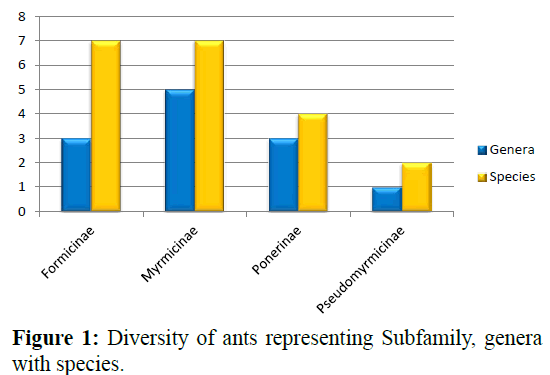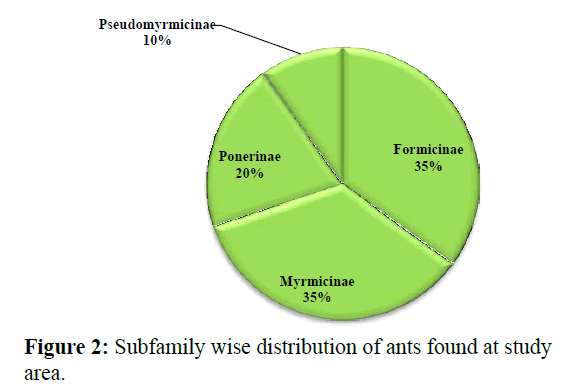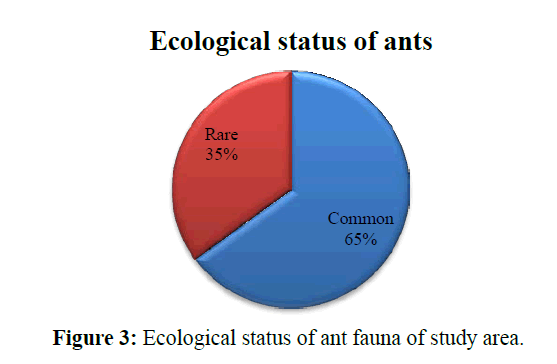Review Article - International Journal of Pure and Applied Zoology (2016) Volume 4, Issue 3
Diversity of Ant Species (Hymenoptera: Formicidae) In the Campus of Maharani?s Science College for Women: A Mini Model of Habitat Persistence
Received 14th July 2016; Accepted 23rd August 2016; Published 29th August 2016
Abstract
The study examined the diversity of ants in the Campus of Maharani’s Science College, Mysuru city, Karnataka, as there is no adequate information pertaining on ant diversity of this region. The present study was carried out during January to June months of the year. We have sampled ants by employing intensive all out search method. This result showed that a total of 978 individuals were captured in the study area. The sampled specimens representing 20 species belonged to 12 genera and four subfamilies. The most diverse subfamily was Myrmicinae (5 genera with 7 species), followed by Formicinae (3 genera with 7 species) and Ponerinae (3 genera with 4 species). The smallest number of species belonged to the Pseudomyrmicinae (1 genus with 2 species). Among the sampled genera, one which showed the highest number of species representation was Camponotus with 4 species. Few ant genera as Crematogaster and Pheidole of Myrmicinae, Camponotus and Polyrhachis of Formicinae and Leptogenys of Ponerinae are mostly found everywhere. Some genera viz; Oecophylla, Meranoplus, Myrmicaria, Solenopsis, Anochetus and Diacamma are represented by lone species each. The present study has yielded valuable information of ant availability in this region and also revealed that the campus of Maharani’s science college, Mysuru has a rich diversity of ants in spite of regular alteration in habitat of these ants. This study has shown the ants could survive against the odds and this study area served as a mini model to examine the persistence of ant species in a locality.
Keywords
Diversity; Ant; Study area; Formicidae; Mysuru
Introduction
Ants are most dominant components of terrestrial ecosystem because of universal distribution, thus constitute greater part of biomass. Ants contribute a conspicuous component of terrestrial biodiversity and are the most divergent group among all social insects. These act as ecosystem engineers. They play very important role in the ecosystem by improving the soil and assisting in the decomposition process. (Watanasit, et al., 2000) and are considered as good biological indicators due to mutualistic behavior with both flora and fauna. These eusocial insects lead high level interactive lives assisting each other to survive and are highly evolved hymenopteran showing polymorphism. Ants belong to the family Formicidae, included in superfamily Vesoidea of order Hymenoptera placed under class Insecta of phylum Arthropoda.
Ants are ubiquitous in distribution and occupy almost all terrestrial ecosystems. There are about 15000 species of ants (Andrade, 2007); only 11,769 species have been described (Agosti, 2004). The family Formicidae contains 21 subfamilies, 283 genera and about 15000 living ant species of which 633 ant species belonging to 82 genera, 13 subfamilies are reported from India. About 226 species of ants belonging to 63 genera and 11 subfamilies are estimated from Karnataka state (Varghese, 2009). The main aim of the present study was to conduct survey, to document the ant species diversity in the campus of Maharani’s science college, Mysuru and prepare a partial checklist of ants in the study area.
Materials and Methods
Study area
The fieldwork was conducted in the campus of Maharani’s Science College, Mysuru City, Karnataka.
The Maharani`s Science College Campus, Mysuru is situated at the heart of the Mysuru city (12°33’ N and 80° 11’ E) covering four and half hectare of land area encompasses Mysuru city (JLB Road) on the east, District Collectors office on to the West. Maharaja Pre university college campus on the North and Hotel Regalis on to the South. The unique interaction throws biological consortia peculiar to this ecosystem. It spreads through the biologically diverse and productive habitat of native flora aesthetically blended with introduced heritage buildings all around the campus.
Habitat characterization
The main type of vegetation in Maharani`s College campus is dry evergreen and scrub comprising of members predominantly belonging to the families: Poaceae, Fabaceae, Cyperaceae, Asteraceae, Euphorbiaceae, Verbenaceae, Solanaceae, Rubiaceae, Convolvulaceae, Amaranthaceae and Asteraceae plants, grass covered land patches and a small garden of mulberry germ plasma, addition to this rest benches arranged at space intervals.
Sampling design
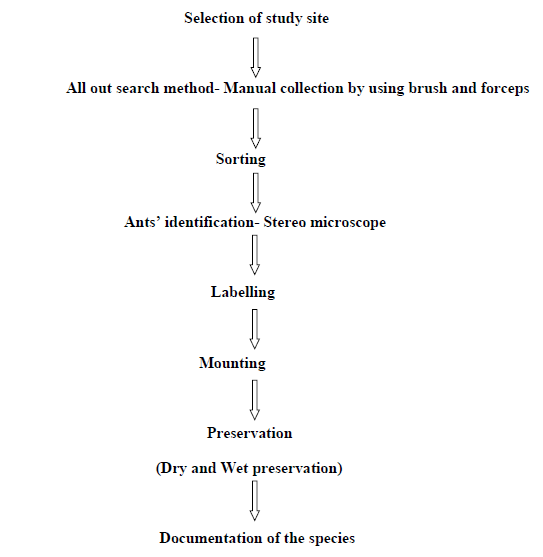
Ant sampling method
Field work was carried out in and around Maharani’s Science College campus, Mysuru. Ant field sampling was done during January to. We employed intensive all out search method. i.e., Manual collection by using a brush and forceps during daytime from 9 AM to 6 PM every day. Generally, mornings and evenings gave best results for all out search method (Gadagkar et al., 1993). The information about Date and time of collection, habitat, locality, was also recorded at the time of collection. The collected specimens were then transferred into vials containing 70% ethyl alcohol. Then ants were brought to the laboratory of Department of Zoology, Maharani’s Science College for identification, labeling and preservation.
Ant cleaning and sorting
Any dirt or adhered material to the body of the ant is cleaned with the help of brush dipped in water. Sorting is most basic thing, which needs to be done carefully. Samples should be segregated from debris and washing in alcohol before preserving them. Immediately after collection all specimens should be sorted out first into similar groups and each group can be named as group 1, group 2 etc. more than one species are not put into the same vial. Use separate vials for different species. It should be kept in separate vials with appropriate labels in order to avoid confusion (Varghese, 2003).
Identification: Ant specimens were tentatively identified up to the genus level by using stereo microscope based on taxonomic keys prepared by Balton in 1994. In cases where identification of species was not possible, specimens were then sent to experts for identification. Species level identification was confirmed by Thresiamma Varghese, Myrmicologist, Centre for Ecological Sciences, Indian Institute of Science, Bangalore.
Labelling
The permanently preserved specimens were provided with identification and data labels. They are written on good quality paper with India ink. Data label should contain the information about date and time of collection, name of collector, the habitat and locality whereas identification label should contain the species common name and scientific name with author, genus, family and order.
Preservation
The collected ants were preserved for a long time by both wet preservation in 70% ethyl alcohol and dry preservation.
Wet preservation/ Liquid preservation
In this method ants can be directly put into separate vials containing 70% ethyl alcohol. All vials should invariably contain small labels showing details of the locality, date of collection, name of the collector, habitat (whether it is arboreal or ground dwelling) and all other possible information about the species. More than one species are not put into the same vial. Use separate vials for different species.
Dry preservation
It is the most advisable method of preservation for ants. In this method ants can be glued down to the apex of a small triangular strip of paper or card, in the region between the fore and middle coxae. Finally push one insect pin through the base of the card. The labels are attached to this insect pin. Pinned specimens should be stored in standard insect boxes. Insect pins of various sizes and insect boxes are available in various scientific supply houses (King and porter, 2004).
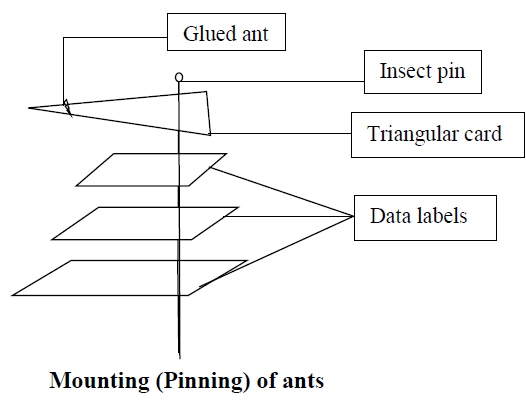
Result
Ant diversity in the campus of Maharani’s Science College, Mysuru has been analyzed in this study. During this study a total of 978 sampled specimens were captured in the study area. The 20 ant species are belonging to 12 genera and four subfamilies. These are as follows, the Myrmicinae were represented by 7 species and 5 genera. The Formicinae were represented by 7 species and 3 genera. The Ponerinae represented by 4 species and 3 genera. The Pseudomyrmicinae represented by 2 species and 1 genus. The most speciose genus of these 4 subfamilies was Camponotus with 4 species.
Among these species Camponotus compressus was high compare to other species and noticeably found in everywhere in study site. The species of Oecophylla and Crematogaster were dominant on tree trunk which nested on trees.
Few ant genera as Crematogaster and Pheidole of Myrmicinae, Camponotus and Polyrhachis of Formicinae and Leptogenys of Ponerinae are mostly found everywhere. Some genera such as Oecophylla, Meranoplus, Myrmicaria, Solenopsis, Anochetus and Diacamma were represented by lone species each.
The Tables 1 and 2 (Figures 1 and 2) shows detailed distribution of diversity of ants. A number of factors seem to be involved in the increased diversity. It includes food resources, nesting habit etc. The environs of the study area are rich in ant species deserve. To date, no research has been conducted on the diversity of ants. The above information will be useful for the preparation of a management plan for the myrmecologists. Total 20 ant species were recorded in the study area during this study. Among them Polyrhachis sp.2, Crematogaster sp.1, Myrmicaria brunnea (Saunders 1842), Pheidole sp., Pheidole watsoni (Forel 1902), Leptogenys sp.3 and Tetraponera sp.2 are rarely found the study area are represented in the (Figure 3) and listed in Table 1.
| Sl.No | Scientific name | Common Name | Ecological Status |
|---|---|---|---|
| 1 | Camponotus compressus (Fabricius, 1787) | Carpenter ant | Common |
| 2 | Camponotus sp.2 | Common | |
| 3 | Camponotus sp.3 | Common | |
| 4 | Camponotus sericeus (Fabricius, 1798) | Common | |
| 5 | Oecophylla smaragdina (Fabricius, 1775) | Weaver ant | Common |
| 6 | Polyrhachis sp.1 | Spiny ant | Common |
| 7 | Polyrhachis sp.2 | Rare | |
| 8 | Crematogaster sp.1 | Rare | |
| 9 | Crematogaster sp.2 | Common | |
| 10 | Meranoplus bicolor (Guerin-Meneville, 1844) | Shield ant | Common |
| 11 | Myrmicaria brunnea (Saunders, 1842) | Harvester ant | Rare |
| 12 | Pheidole sp. | Big headed ant | Rare |
| 13 | Pheidole watsoni (Forel, 1902) | Rare | |
| 14 | Solenopsis geminate (Fabricius, 1804) | Fire ant /thief ant | Common |
| 15 | Anochetus sp. | Trap jaw ant | Common |
| 16 | Diacamma ceylonense (Emery, 1897) | Queenless ant | Common |
| 17 | Leptogenys sp.3 | Long legged ant | Rare |
| 18 | Leptogenys processionalis (Jerdon, 1851) | ||
| 19 | Tetraponera sp.2 | Arboreal ant | Rare |
| 20 | Tetraponera rufonigra (Jerdon, 1851) | Common |
Table 1: Checklist of Ants in the Maharani’s Science College Campus, Mysuru city.
| Sub Families | Genera | Species Found |
|---|---|---|
| Formicinae | Camponotus | 4 |
| Oecophylla | 1 | |
| Polyrhachis | 2 | |
| Myrmicinae | Meranoplus | 1 |
| Myrmicaria | 1 | |
| Pheidole | 2 | |
| Crematogaster | 2 | |
| Solenopsis | 1 | |
| Ponerinae | Anochetus | 1 |
| Leptogenys | 2 | |
| Diacamma | 1 | |
| Pseudomyrmicinae | Tetraponera | 2 |
| TOTAL | 12 | 20 |
Table 2: Summary of ant species collected from sampling site.
Discussion
Maharani’s college campus is about 100 years old the campus area has undergone several modifications in the form of floral cultivations extension of permanent structures, which has become more rapid in the past few years. Campus is located on the edge busy road with high rate of vehicular traffic this imminently has increased air pollution around compared to years past, also noise of vehicles and vibration of the vehicular movement has raised to a disturbing level. On the campus gardening has been done each year as a regular process leading to digging, change of soil, replacement of soil, additional manuring, burning of litter, change of plants and grass that has resulted change of topological profile of ant ‘s ecosystem in this campus.
It seems none of the factors related to air or soil pollution has affected existence of the ants and their abundance in the campus as these could be collected from this campus each year without any visible changes in their availability. A total of 4 subfamilies, 12 genera and 20 species of ants were recorded from the campus of Maharani’s Science College, Mysuru. The majority of species were in the Myrmicinae (35%) and Formicinae (35%) followed by Ponerinae (20%). At the genus level, Camponotus, Polyrhachis, Pheidole and Crematogaster were the most speciose genera in this study with 4, 2, 2 and 2 respectively. Myrmicinae were the most abundant in numbers of ants and the most diverse group (7 Species) in this study area. This family showed a significant difference between seasons (Watanasit et al., 2000) as recorded by other elsewhere. The number of individuals was higher in the wet season. They nested in soil humus, in hollow twigs, under bark, inside galls or in nuts of woody plants. It is therefore not surprising that we collected them in greater numbers. These ants were more specific due to availability of food and nesting sites. These are also the exclusively arboreal and terrestrial taxa. Pheidole nested in soil, Crematogaster nested in dead wood on trees, Myrmicaria nested at tree base, Meranoplus had nests in open canopy areas and Solenopsis nested under rocks and rotten logs, these findings also coincide with our observations in the campus. The Formicinae were the most abundant in the study area. The extreme dominance exhibited by Formicinae sub family with seven species in this study. Formicinae did not show a significant difference between seasons. Humidity may influence nest building. The genus Camponotus were record of four species. Camponotus was a frequently occurring species in everywhere. The Camponotus had the greatest individual numbers. These ants are called as carpenter ants because of their “Nesting behaviours” (Chavhan et al., 2011). Food sources may have been important (Watanasit et al., 2000). The most common among them were Oecophylla smaragdina, a truly arboreal species. These ants nested in shady places and require broad leaves to stitch their nest. All the recorded species of Polyrhachis were arboreal and found in undisturbed areas. These ants nested on the ground such findings were also recorded in this study though not to such an extent of work. Ponerinae subfamily was more specific about its niche and food habits ( Ramachandra et al., 2012). They feed on a wide range of food. Food resources may have played an important role influencing numbers of Ponerinae (Watanasit et al., 2000). Anochetus and Diacamma were nested in soil or even in rotten logs. Leptogenys prefer cavities in logs or large branches to construct their nests. Only one genus Tetraponera representing Pseudomyrmicinae has been recorded. Neither seasonal change nor did physical factors influence the numbers of this group. These are solitary foragers and make their nests in fallen dead wood and rotten logs. Tetraponera rufonigra was dominant compared to Tetraponera sp.2 in the study area.
Ants exhibit a greater resistance to pollutants in comparison to other invertebrates(Torrasssian and Causse, 1998; Le Masne and Cougourdan, 1972) even to industrial pollutants (Petal et al., 1995) . This kind of resistance and adaptability has been assigned to two reasons first being that only 10% of the ants are outside the during active phase of the day and the other reason that ants change the pattern of activity on exposure to pollutants, often the density of reduce with increase in pollution (Folgarite, 1998 ). The richness has been correlated with the composition of the plant species invertebrate and microbial biomass (Majer et al., 1982; Anderson 1997; Anderson and Sparling, 1997).
With all the atrocities on the habitat of ants in college campus these have showed continued existence and have persisted through the years and generations. The rich diversity of the ants documented during this study may be because of adequate nesting sites and availability of food as well foraging. The high diversity of ants in this area is showed that this area is good habitat for ants. This study has shown the ants could survive against the odds and this study area served as a mini model to examine the persistence of ant species in a locality.
Conclusion
The present investigation on diversity of ants in the Maharani`s Science College Campus, Mysuru clearly shows the richness of ants fauna in the city. We have recorded 20 species of ants belonging to 4 subfamilies. The campus of Maharani’s Science College, Mysuru city has gone several changes through years embodies ant diversity and could be considered as a mini model of habitat persistence by ant species. The present study will yield valuable information of ant availability in the region.
References
- Agosti, D., Majer, J., Alonso, L. and Schultz, T., 2000. “Litter ant communities of the Brazilian Atlantic Rain forest region”.
- Andrade, T., 2007. “Diversity of ground dwelling ants in Cerrado: An Analysis of temporal variations and distinctive Physiognomies of vegetation Formicidae:Hymenoptera. 50.
- Andersen, A.N., 1997. Measuring invertebrate biodiversity surrogates of ant species richness in the Australian seasonal tropics. Mem. Mus. Victt., 56: 355-359.
- Andersen, A.N. and Sparling, G.P., 1997. Ants as indicators of restoration success: relationship with soil microbial biomass in the Australian seasonal tropics. Rest. Ecol., 7: 109-114.
- Bolton, B., 1994. “Identification Guide to the Ant Genera of the World”. Harvard University Press, Cambridge, Massachusetts, USA. pp: 222.
- Chavhan, A. andPawar, S.S., 2011. “Distribution and Diversity of ant species in and around Amravati city of Maharashtra, India”.pp: 395-400.
- Gadagkar, Padmini, N.,Chandrashekara, K. andBhat, D.M.,1993. “Ant species richness and diversity in some selected localities of Western Ghats, India”.pp: 79-94.
- Guruprasad, B.R. andTiwari, A.K.,2011. “Ant: Handbook of Insect Biology”. pp: 38-59.
- King, J.R. and Porter, S.D., 2004. “Recommendations on the use of alcohols for preservation of ant specimens”.pp: 197-202.
- Le Masne, G. and Bonavita-Cougourdan, A., 1972. Premiers reÂsultstsd'une irradiation prolonge e au ceÂsiumsur les populations de fourmis en Haute-Provence. EkologiaPolska 20: 129-144.
- Majer, J.D.,Sartiori, M., Stone, R. and Perriman, W.S., 1982.Recolonization by ants and other invertebrates in rehabiliated mineral sand mines near Enebba, Western Australia.Recl. andReveg. Res. 1: 63-81.
- Petal, J., Jakubczyk, H., Chmielewski, K. and Tatur, A., 1975. Response of ants to environmental pollution. In Progress in Soil ZoologyJ. Vabek, ed.,pp. 363-373.
- Ramachandra,T.V., Chandran, S. and Joshi, N.V.,2012.“Ant species composition and diversity in the Sharavathi river Basin- Central Western Ghats”. pp: 1-51.
- Staffan, B., and Maclsaac, A.M., 2002. “A preliminary study of ant diversity and of ant dependence on dead wood in central interior British Columbia”.pp: 111-119.
- Sunil Kumar, M., Srihari, K.T., Nair, P. and Gadagkar, R.,1997. “Ant species richness at selected localities of Bangalore”.pp: 3-5.
- Torossian, C. and Causse, R.,1968.E€etsdes radiations gamma sur la fertlite et la longeÂvite des colonies de Dolichoderusquadripunctatus. Compterendu du Colloque ``Isotopes and radiation in entomology''. International Atomic Energy Agency, Vienna.pp: 155-164.
- Varghese, T.,2003. “Ants of the Indian Institute of Science Campus. Technical report No. 98, Centre for Ecological Sciences, Indian Institute of Science, Bangalore”.
- Varghese, T.,2009. “A Review of Extant Subfamilies, Tribes and Ant Genera in India”.pp:81-89.
- Watanasit, S. and Bickel, T.O., 2000. “Diversity of Ants from Ton Nga Chang Wildlife Sanctuary,Songkhla,Thailand”. pp:187-194.
